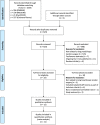Clinical effectiveness of tenotomy versus tenodesis for long head of biceps pathology: a systematic review and meta-analysis
- PMID: 36220319
- PMCID: PMC9557260
- DOI: 10.1136/bmjopen-2022-061954
Clinical effectiveness of tenotomy versus tenodesis for long head of biceps pathology: a systematic review and meta-analysis
Abstract
Objectives: The comparative clinical effectiveness of common surgical techniques to address long head of biceps (LHB) pathology is unclear. We synthesised the evidence to compare the clinical effectiveness of tenotomy versus tenodesis.
Design: A systematic review and meta-analysis using the Grading of Recommendations Assessment, Development and Evaluation approach.
Data sources: EMBASE, Medline, PsycINFO and the Cochrane Library of randomised controlled trials were searched through 31 October 2021.
Eligibility criteria: We included randomised controlled trials, reporting patient reported outcome measures, comparing LHB tenotomy with tenodesis for LHB pathology, with or without concomitant rotator cuff pathology. Studies including patients treated for superior labral anterior-posterior tears were excluded. No language limits were employed. All publications from database inception to 31 October 2021 were included.
Data extraction and synthesis: Screening was performed by two authors independently. A third author reviewed the article, where consensus for inclusion was required. Data were extracted by two authors. Data were synthesised using RevMan. Inverse variance statistics and a random effects model were used.
Results: 860 patients from 11 RCTs (426 tenotomy vs 434 tenodesis) were included. Pooled analysis of patient-reported functional outcome measures data demonstrated comparable outcomes (n=10 studies; 403 tenotomy vs 416 tenodesis; standardised mean difference (SMD): 0.14, 95% CI -0.04 to 0.32, p=0.13). There was no significant difference for pain (Visual Analogue Scale) (n=8 studies; 345 tenotomy vs 350 tenodesis; MD: -0.11, 95% CI -0.28 to 0.06, p=0.21). Tenodesis resulted in a lower rate of Popeye deformity (n=10 studies; 401 tenotomy vs 410 tenodesis; OR: 0.29, 95% CI 0.19 to 0.45, p<0.00001). Tenotomy demonstrated shorter operative time (n=4 studies; 204 tenotomy vs 201 tenodesis; MD 15.2, 95% CI 1.06 to 29.36, p<0.00001).
Conclusions: Aside from a lower rate of cosmetic deformity, tenodesis yielded no significant clinical benefit to tenotomy for addressing LHB pathology.
Prospero registration number: CRD42020198658.
Keywords: Adult orthopaedics; Musculoskeletal disorders; Orthopaedic sports trauma; Shoulder.
© Author(s) (or their employer(s)) 2022. Re-use permitted under CC BY-NC. No commercial re-use. See rights and permissions. Published by BMJ.
Conflict of interest statement
Competing interests: None declared.
Figures




References
-
- Postacchini F. Rupture of the rotator cuff of the shoulder associated with rupture of the tendon of the long head of the biceps. Ital J Orthop Traumatol 1986;12:137–49. - PubMed
Publication types
MeSH terms
LinkOut - more resources
Full Text Sources
Medical
